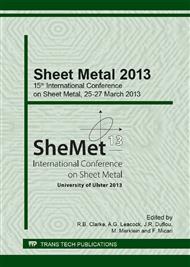p.333
p.340
p.349
p.356
p.364
p.372
p.381
p.389
p.397
A Microstructural Investigation of Roll Formed Austenitic Stainless Steel
Abstract:
Due to high production rates and the possibility to form complex geometries roll forming has become an increasingly popular forming process for sheet metal. Increasing quantities of high strength steels are used today but can be difficult to form due to their low ductility. One way to partly overcome this problem is to heat the steel in the forming area thus locally increasing the ductility. In the present study partially heated cold rolled high strength AISI 301 type austenitic stainless steel was investigated using electron backscattered diffraction (EBSD), and the results were compared to microhardness measurements. The results show that partial heating will give an almost complete reverse martensite transformation, i.e. martensite (α ́) transforms to austenite (γ), close to the surfaces and grain growth in the middle of the steel sheet. The extension of the heat affected zone can be determined using either microhardness or EBSD measurements. Both these measurements can be used to determine the position of the neutral layer after roll forming. The hardness measurement cannot distinguish between microstructural features but the results are in good agreement with the EBSD results for volume fraction of α ́-martensite. A major advantage of using EBSD is the possibility to characterize and follow the microstructural development when heating and roll forming.
Info:
Periodical:
Pages:
364-371
Citation:
Online since:
April 2013
Authors:
Price:
Сopyright:
© 2013 Trans Tech Publications Ltd. All Rights Reserved
Share:
Citation:


